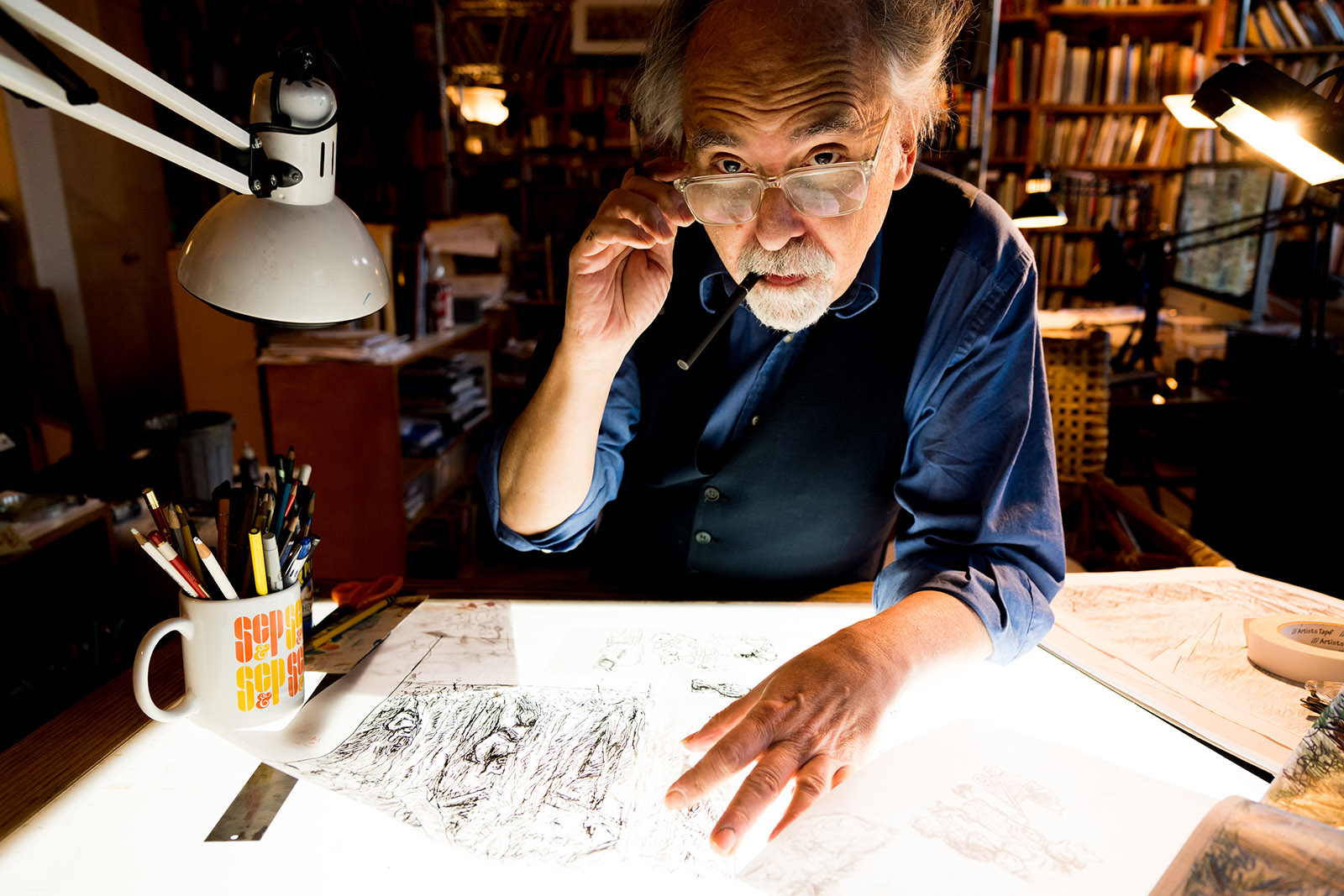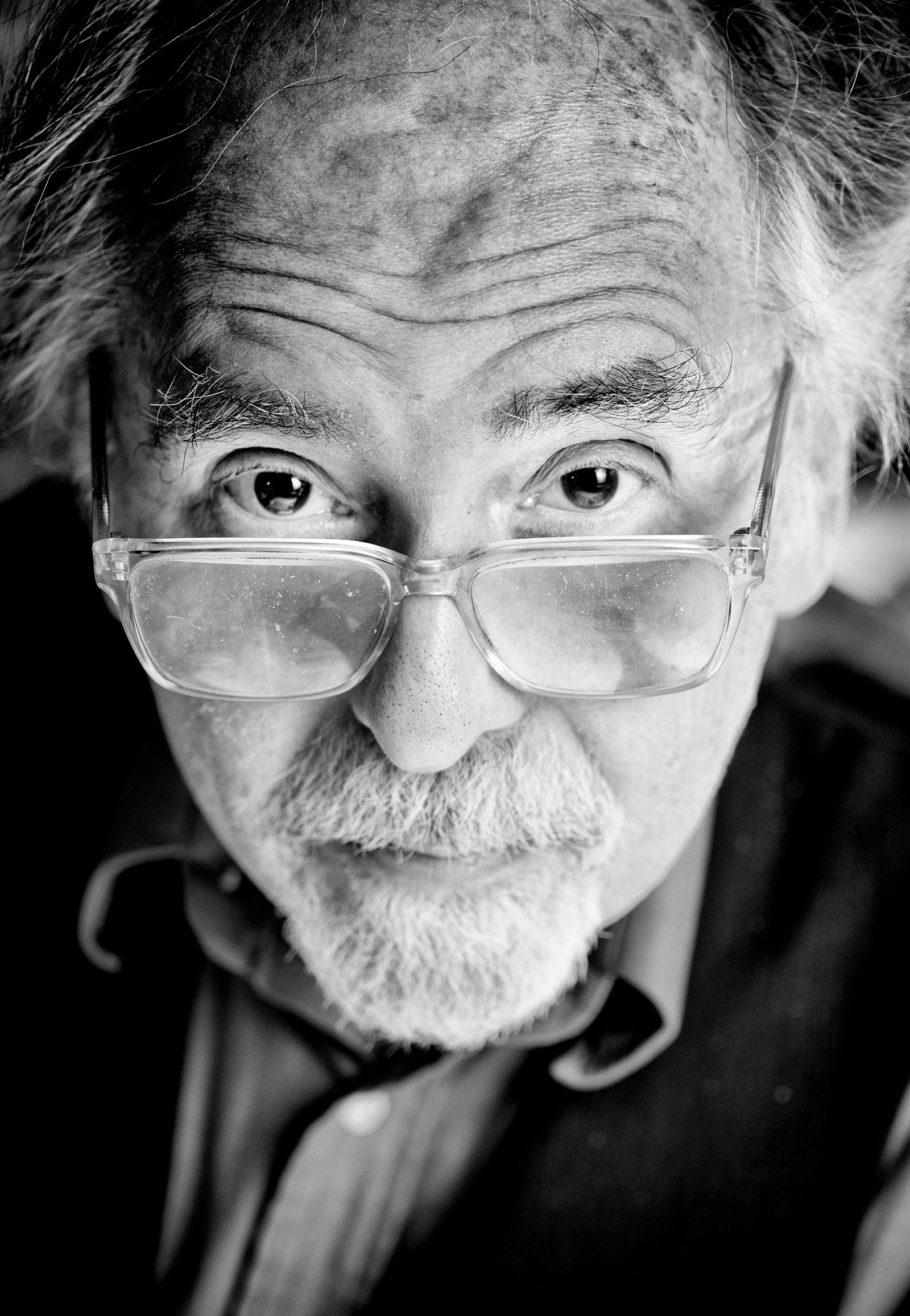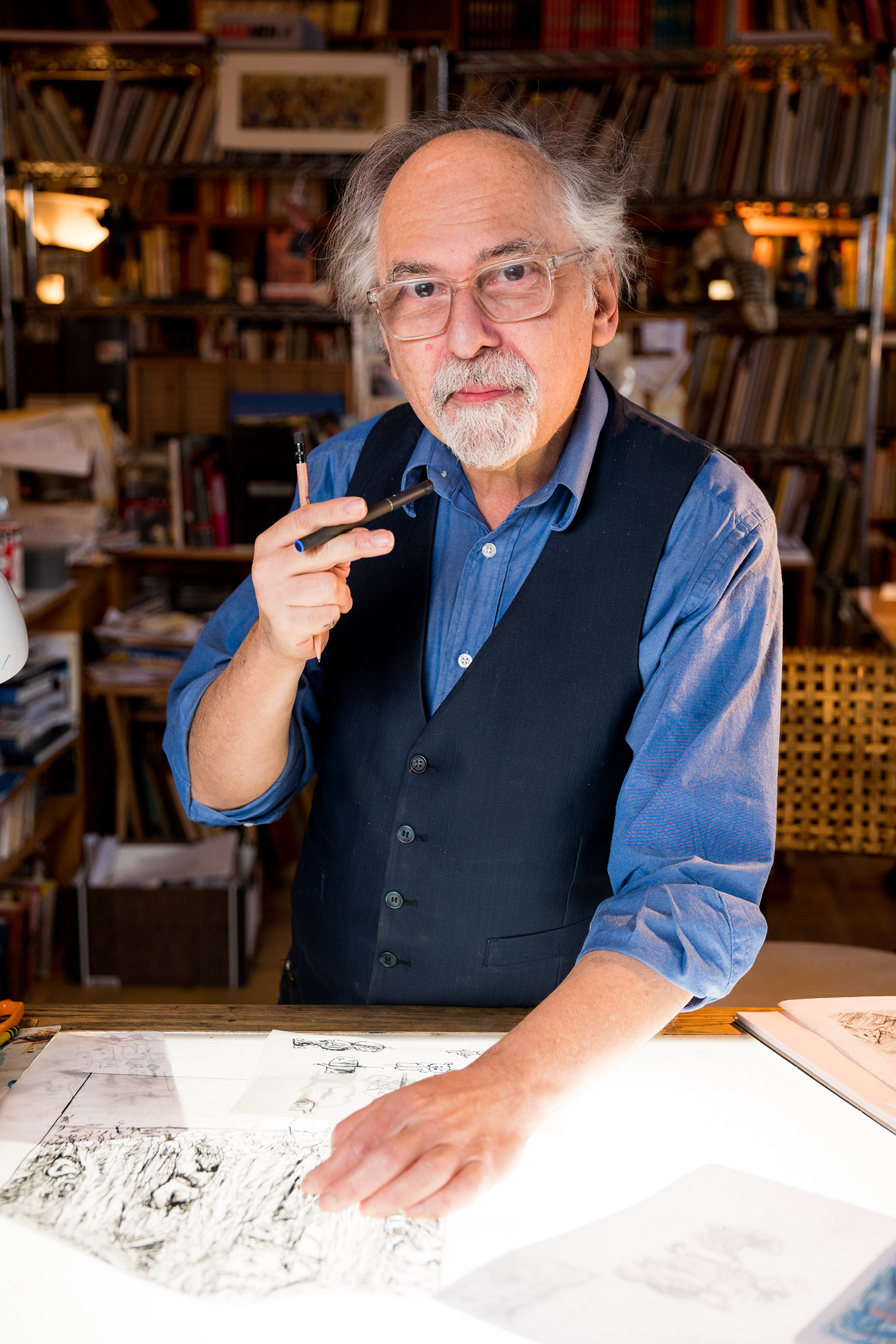When this interview was first proposed to the cartoonist, writer, and graphic novelist Art Spiegelman, he seemed puzzled by the pitch. “Why do you want to do that?” he asked. “There are a lot of other cartoonists who are on fire trying to find a place for themselves. I’m not there.”
It’s true that he doesn’t need the publicity. At seventy, he enjoys a success that few in the cartooning world can match. This once “underground” cartoonist is a Chevalier de l’Ordre des Arts et des Lettres, has been a Guggenheim fellow, has two honorary doctorates and a Pulitzer Prize, to mention just a few of his awards and honors. There have been one-man exhibitions at the Museum of Modern Art and at the Jewish Museum and, perhaps even more important to him, a guest appearance on The Simpsons.
The glory began in a left-handed way in the late 1970s when Spiegelman started experimenting with a project that combined his drawings, psychotherapy, family history, and the thing he loved most in the world—comics. After many tries, what developed was Maus, a two-volume 296-page comic, eventually published by the late André Schiffrin at Pantheon Books. Maus examined Art Spiegelman’s pained connection to his parents, who were Auschwitz survivors, and the terrible legacy their story had bequeathed to him. How do you grow up a “normal” American kid when your parents wake up in the night screaming? How do you get the nerve to make a comic book about it?
We spoke twice, for a total of three hours, at Spiegelman’s studio in the Soho district of Manhattan. A condensed and edited version of the conversation follows.
—Claudia Dreifus
Claudia Dreifus: What are you working on right now?
Art Spiegelman: I’m not working on a graphic novel. At this moment, I only work when I feel the need.
Frankly, I’m “comfortable” in a way that makes me uncomfortable. At the same time, I need to do something with my brain, and so I explore whatever is churning through without necessarily going public with it or publishing.
Mostly, I’ve been reading and writing about the lives of artists I admire. I wrote an essay for Harper’s that was based on a very short introduction to a book on the early twentieth-century political cartoonist Art Young. Young was the art editor of The Masses and later The New Masses, a radical who was put on trial for his opposition to World War I. He was probably the most humane and touching political cartoonist America ever produced.
Before that, I spent an entire year writing, editing, and designing a book called Si Lewen’s Parade. Si Lewen was this ninety-seven-year-old artist I’d met and liked. He had this beautiful antiwar suite of sixty or seventy drawings that made up a story. As someone who has had a hard time finding father figures, I found, with him, a crazy uncle I enjoyed hanging out with. He died in 2016 just before his ninety-eighth birthday.
I’ve also been doing some single-page comics, and I’ve done several that I’m satisfied with. With them, I’ve made something that I can control from upper-left to lower-right and everything in-between and that are worth rereading. I don’t know what you’d call them? Maybe: graphic short stories?
Has your agent been after you to make another graphic novel?
My agent has been wonderful. Anything I want to do, his office will find a publisher for. But then, every year, Maus sells as if it were a new book. It’s in twenty-plus languages. In January, it was number thirty-six on Amazon! That means it’s not economically important for me to find my next graphic novel. It means I can afford to live in Soho.
Actually, I don’t think I’ll ever make another graphic novel. Maus came out of the impulse of wanting to make a long comic that needed a bookmark and that begged to be reread. After I finished it, I did not think, “Aha. Now I’ve found my perfect form.” Drawing it was a struggle. Drawing is always a struggle.
In the early 1970s, when you began creating early drafts of Maus, did you think it would become a classic?
Did I think Maus would become be canonical? I thought, “Maybe after my death.”
Part of what I was doing with Maus was trying to work out my personal issues, which involved understanding the places where world history had smashed up against my family’s history. Another part was trying to find out what was under the hood of the underground comic. What were they as a formal medium? What possibilities did they offer? Maus was meant to be a demo of that.
Advertisement
How did the idea for the storyline of Maus first come to you?
Earliest Maus began with a short strip about my mother’s suicide done as an underground comic called “Funny Aminals.” It was published in 1972. Around that time, I began to feel this urgency to do something big—a book-length comic of some kind. There was no word for what I had in mind. I certainly didn’t use the term “graphic novel.” I’m still not enamored of it, though people tell me that it’s great for marketing.
At first, I had no settled idea for a topic. One thought was to make something encompassing the last hundred years of American comics, with a fictional cartoonist as the protagonist. The other involved expanding on interviews I’d begun with my father for “Funny Aminals.” I could see there was still a lot of unfinished business there. I’d also just moved back to New York from San Francisco, and I knew I’d have to be in touch with my father, one way or the other. We didn’t get along. Ironically, we found common ground in talking about Auschwitz.
One factor that made me go with the second option was that, at the time, there wasn’t a popular culture that was talking about a Holocaust. Today, we’re at a point where, I don’t know, every year at the Academy Awards, there seems to be a Best Holocaust Movie award, separate from all others. But that wasn’t true in the early 1970s.
I take it that you are no fan of Schindler’s List?
I think of it as the feel-good version of that S&M cult classic The Night Porter. There’s a scene in Schindler’s List in which the commandant played by Ralph Fiennes is in bed with a woman, and he takes his handgun and shoots some Jew he sees out the window. The message there, inextricably linked, is that all sex leads to holocausts. They are somehow joined at the hip: the two concepts.
As troubling was the Best Foreign Film in 1999, Life Is Beautiful. It said, ultimately, that if only the victims could just have taken it all with a song in their hearts and tap-danced their way, Chaplin-like, through the barbed wire, then “life” would be “beautiful.” I read somewhere that the director said he’d been inspired by Maus. If that’s true, I would have liked to go back in time and yank the book out of his hands!
Did creating that graphic novel help you come to terms with the difficulties of growing up as the child of Holocaust survivors?
You know, when Maus was first published, in 1986, people asked me that same question. My answer then was, “I’ve had therapy, and I’ve made comics. The comics are cheaper.”
That said, I had a lot of unexpected problems in making the book. The whole thing took longer than expected—thirteen years. I kept ducking in and out of depression. I was not prepared for the first volume of Maus to be brought out by a respected publishing house and be thought of as an important work. I thought it would probably have to be self-published or printed by a small press. The success of the first volume set me back.
I was really lucky to have found Paul Pavel for a therapist. He was a Holocaust survivor himself and, in some ways, he was a collaborator in what I produced. With him, I was able to find a father figure who was more articulate and perhaps a better person than my own.
At one point, he told me, “But you weren’t in Auschwitz. You were in Rego Park.” With that, he was saying, “deal with your own reality, not your father’s.” I tried to incorporate that into the book. So, to answer your question: working on the book helped with both.
The second volume of Maus opened with this unforgettable tableau of you at your drawing table, working away over the bodies of Holocaust victims. How did the idea for that frame develop?
That was a concrete realization of what I was feeling while I was creating some of the material in Maus II.
In my line of work, one is always hunting for that essentialization. Comics do that especially well. They permit you to boil down an image and a thought to its essence, with the two circuits mixing the words and images. In that frame, I drew myself sitting over the dead bodies, while people are clambering up the mound in order to interview me about how swell Maus I was. It was how I felt.
Advertisement
To fast-forward to the present, if you were drawing Donald Trump as an animal, who would he be?
I don’t know. A very conventional part of my brain goes, “He’s a… wild boar.” Except that pigs are intelligent. Now, I have drawn him as bloated frog. More recently, I drew him as a large turd.
You know, if he were just on television, I’d be glad to watch. But living through this, it’s too Sensurround for me. He’s like the person who’s traveling late at night in the subways, and acts a little crazy to protect himself. You twitch so that the other twitchers will leave you alone. This guy has perfected acting crazy—and he probably is crazy. I am appalled it works.
You said earlier you were spending a lot of time reading. What have you been looking at?
Emil Ferris’s My Favorite Thing Is Monsters. What I admired about her was that she had taken so long to gestate her first book—she was nearly fifty, I think—and that she had to relearn how to draw after West Nile virus left her unable to hold a pencil. Yet she came out with this book that was very accomplished visually—on some level, inspired by Robert Crumb’s sketchbooks; on another, by Maus, in wanting to make a long complex story. If you look at it page by page, it accumulates into an understanding of how the artist is thinking. Ferris uses all the visual apparatus of a sketchbook to tell a very complex narrative that moves through her childhood transmuted into a fiction.
I’ve also been reading about Philip Guston, an American painter who started out in the 1930s in Los Angeles, inspired by the Mexican muralists. Chris Ware recently did a piece about him for the New York Review Daily. Guston developed into being a highly-regarded second-generation abstract expressionist, and was literally excommunicated from that world when he began returning back to his cartooning roots. He’d taken a cartoon course as a kid. Later in his life, in the 1970s, he was outraged by Nixon and he made these amazing pictures filled with his hatred for Nixon. Ultimately, he came to this understanding that Nixon was inside him.
As for me, I can’t find a way to draw Trump with empathy and to deal with the situation with empathy. I have this visceral nausea that comes with having to hear him.
Have you been protesting?
I did go to the two women’s marches and I found them exhilarating. For both the demonstrations, my wife, Françoise Mouly, and my daughter, Nadja Spiegelman, edited a cartoon magazine that we gave out for free to the marchers. Resist was 99 percent women—professional cartoonists, kids, old people, young people, anyone who wanted to say something. I lobbied for a man-cave, so there are a few pages of male artists, as well.
Having opened up some space for it, I tried to create something about Trump, and it was crazy-making. One of the problems was not knowing a punchline. Is this comedy or tragedy? Will we be able to reel ourselves back or are we on some doomed ship heading out to sea? Until you know that, it’s hard to know what tone to take. The “you can’t make this shit up” factor also gets in the way. It’s hard to make a cartoon of a cartoon.
In the end, I contributed a couple of pieces to Resist and then [when] we went to the marches where we gave the magazines out to the other demonstrators. I went, “Free comics—free. Everybody loves comics. Everybody loves America. Free, free—just like America used to be.”
What was the reaction?
People were happy to have them. People love comics. They are easy to read.
Your daughter, Nadja, published I’m Supposed to Protect You From All This: A Memoir in 2016. It’s about the women in her mother’s family. With all that has been published about the patrilineal side of her heritage, was that her way of escaping the Spiegelman saga?
In the family, we have a creature called the “Spiegelmonster.” We’re all ambivalent about him. But I just have a walk-on part in the book. It makes sense that her book is totally focused on examining the history and relationships of her mother’s family going back to her great-grandmother. She’s a very smart girl.
Do you ever worry about reliving your parents’ experience?
I used to. I grew up in Rego Park in Queens and half the people who lived on our block were Irish Catholics who thought I had personally killed Christ. In the present moment, I feel that we Jews have been made officially white, or at least off-white. With so many darker colors on the frontlines today, it’s hard for me to think of myself as among those most likely to be yanked out and whipped into a prison cell.
What about the events last year in Charlottesville, where native-grown Nazis paraded around chanting things like, “You will not replace us?” The “You” were Jews. What were your feelings when you saw that?
Fuck! It happened. It’s not like I didn’t imagine things like this happening. But even in the prejudiced New York world I grew up in, I thought blacks were in greater danger than Jews. As for the Charlottesville Nazis, if they were after me, it would probably be more for the contents of my brain than the color of my skin.





